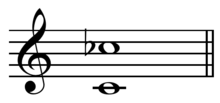| Inverse | Augmented unison |
|---|---|
| Name | |
| Other names | Diminished eighth |
| Abbreviation | d8[1] |
| Size | |
| Semitones | 11 |
| Interval class | 1 |
| Just interval | 48:25, 256:135,[2] 4096:2187 |
| Cents | |
| Equal temperament | 1100[2] |
| Just intonation | 1129, 1108,[2] 1086 |
In classical music from Western culture, a diminished octave is an interval produced by narrowing a perfect octave by a chromatic semitone.[1] As such, the two notes are denoted by the same letter but have different accidentals. For instance, the interval from C4 to C5 is a perfect octave, twelve semitones wide, and both the intervals from C♯4 to C5 and from C4 to C♭5 are diminished octaves, spanning eleven semitones. Being diminished, it is considered a dissonant interval.[3]
The diminished octave is enharmonically equivalent to the major seventh.
Sources
- ^ a b Benward & Saker (2003). Music: In Theory and Practice, Vol. I, p.54. ISBN 978-0-07-294262-0. Specific example of an d8 not given but general example of perfect intervals described.
- ^ a b c Duffin, Ross W. (2008). How equal temperament ruined harmony : (and why you should care) (First published as a Norton paperback. ed.). New York: W. W. Norton. p. 163. ISBN 978-0-393-33420-3. Retrieved 28 June 2017.
- ^ Benward & Saker (2003), p.92.

